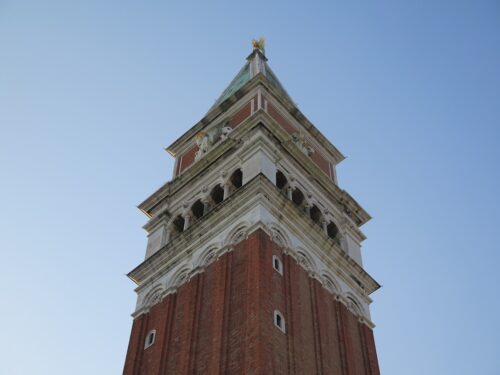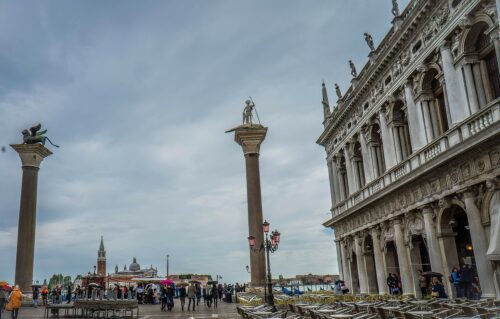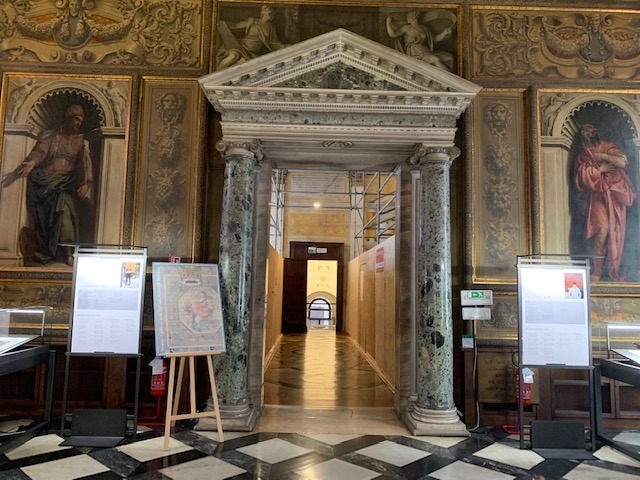Piazza San Marco
There’s no way you can go to Venice and miss its most famous attraction, the Piazza San Marco. This massive architectural and archaeological park is the biggest open space in the city and the only square given the name piazza (all others are referred to as campi).
San Marco square has been the biggest nucleus of social life in Venice since its very beginning in the early 9th century when it was just a small clearance in front of the first church of St. Mark.


The magnificent basilica that acquired its backbone shape in 1071 lies on the eastern edge of the trapezoid square. It is right back to another iconic symbol of the city which is also the oldest surviving structure of the square, the 99 meters tall Campanile tower.
El paron de casa (The Lord of the House) the affectionate term used by the Venetians for their beloved Campanile was built between 888 and 912 during the dogeship of Pietro Tribuno at the site of a 7th-century structure, probably a lighthouse.
In 1173 the first belfry was inserted at its top which was however considered unfitting for the refined Venetian aesthetics and was replaced with the arched, granite columned, and oriental marbled bell tower we see today between 1511 and 1513.


The bricked attic is adorned with the white marble sculpture of Justice holding gilded balance scales in one hand and a gilded sword in the other and white marble sculptures of the winged lions, symbols of the Republic of Venice. It was completed with the pyramidal spire and the gilded wooden statue of the Archangel Gabriel that was placed on the summit after a ceremony where milk and wine were poured as a sign of joy and as a propitiatory offertory.
At its base, facing San Marco Church lies the Loggetta built by Jacopo Sansovino, architect of the Biblioteca Marciana we encounter in the adjoining Piazzetta and also responsible for the unification of the two (The Piazza & the Piazzetta). It was this unification that created the need for a more sumptuous structure in place of the older & smaller loggia that stood on the site before 1537.


It is covered by sumptuous white and colored oriental marble and Istrian stone, and its facade is lined with four bronze statues, Athena symbolizing the wisdom of the government, Apollo for the harmony of the Republic and nature, Mercury for careful thoughts and action and Peace for the city’s pacifist nature..well..those were the ideals on the ground floor.
The attic’s reliefs tell the story of the Venetian empire and the power of the sword. Jupiter symbolizes his kingdom of Crete and Venus the realm of Cyprus. Presiding over them the depiction of Justice. Although a very costly construction, it didn’t serve any formal function aside from some casual meetings of the Venetian elite. It was more of a statement linking Venice with the glorious Greco-Roman dominance of the Mediterranean.


On the north side of the church and the campanile (on their right side as we face them) is a second, smaller square, the Piazzetta di San Marco that leads to the waterfront and the two granite columns carrying the symbols of the two patron saints of the city, Saint Theodore (on the right side as we face the sea, holding a spear) and Saint Mark (the winged lion on the left side).
The Piazzetta lies between the Venetian Republic’s own White House, the Doge’s Palace (on the left side as we face the sea), and the Renaissance masterpiece of Jacopo Sansovino, the Biblioteca Marciana.


This unique treasure trove of architectural and historic treasures formed by the two squares of San Marco lies in the dreams of everyone who has ever dreamed of setting foot in this mesmerizing city. It is its symbol and its epicenter even for the hundreds of pigeons that refuse to abandon it despite the “no feeding” policies.
It is one of the biggest and most scenic swimming pools if you happen to visit at the time of aqua alta and the place you will probably have one of the most expensive cups of coffee in your life if you choose to sit in one of its oldest & most famous tourist traps, the Cafe Florian to name just one. And why not after all? Venice is not a place to be thrifty.




